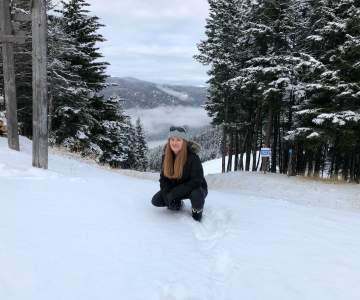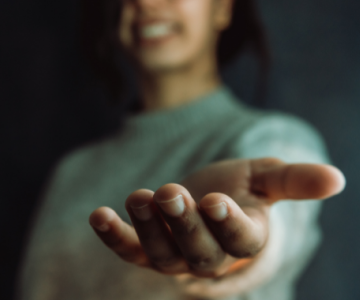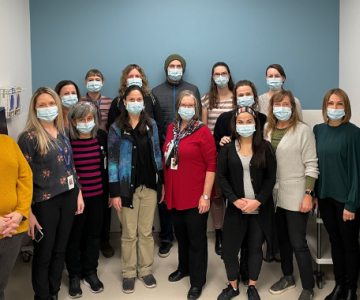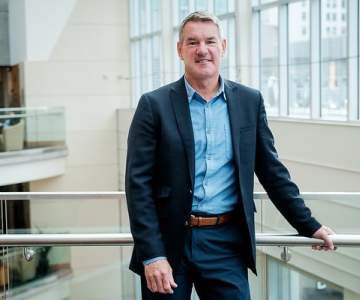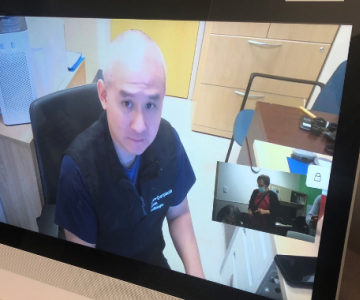Breadcrumb
Explore Stories
Health & Wellness
Last week, Interior Health began offering the paediatric COVID-19 vaccines to children age five to 11 in communities across the region. The response from families and communities has been positive and thousands of children in this age group have already booked appointments across B.C.
Many families have expressed how relieved and grateful they are to have their younger children vaccinated against COVID-19. There are also others who have questions, understandably, and it is important we continue to make it easy for parents and guardians to have access to the factual information they need to make the decision to get everyone in their family vaccinated.
The paediatric Pfizer vaccine is available for five to 11 year olds in B.C. It is a smaller dose of the same vaccine administered to millions people globally over the past year.
There were no severe reactions in children during clinical trials and any mild side effects (sore arm, fever) subsided in a day or two. In our clinics across IH, specially trained pediatric immunizers and public health nurses are on hand to provide care and support children receiving the vaccine.
Like youth and adults, we know children need protection from COVID-19. Since Sept. 1, children aged five to 11 have accounted for 16 per cent, or close to 2,000 of COVID-19 cases in the Interior region, the highest rate of infection of all age groups.
While most of these children experience mild to moderate illness from the COVID-19 virus, some children can get severely ill requiring hospital admission while others can have lingering symptoms or health issues long after their infection. Vaccination will help reduce this risk and these impacts.
Data from studies of children aged five to 11 has shown that the vaccine is 91 per cent effective against preventing COVID-19 infections, and even better for preventing severe illness and hospitalization. This level of immunity is remarkable. Still, we know that the body takes time to build its immune response and that full immunity is achieved about seven days after the second dose.
I know some families are tempted to “wait and see,” and to put off the decision to vaccinate children for a few months. However, as we head into the holiday season and winter gatherings, vaccination offers the best protection – now and in the first months of the New Year.
When children are immunized, not only are they better equipped to fight off infection, but they’re less likely to need to miss school or social activities that are important to their well-being. They’re also less likely to spread the virus to others, including grandparents, aunts and uncles, neighbours or people with compromised immune systems. Don’t delay the benefits by waiting longer than necessary.
Now is the time to consider the reasons that are important to your family and to register your children to be vaccinated at gov.bc.ca/vaccineforkids and if you have any questions or concerns, please speak with your family’s care provider, call 8-1-1 or learn about COVID-19 vaccines for children 5-11 at interiorhealth.ca.
About the author
Dr. Sue Pollock is Interior Health's interim chief medical health officer.
Community & Culture
We are IH is a recognition campaign to spotlight Interior Health employees and medical staff – through pictures and stories.
Name: Tracey Thoss
Job Title: Administrative Services
Years of Service: 3 Years
Worksite: Kamloops Mental Health and Substance Use
Community: Kamloops
Ancestral Territory: Tk’emlúps te Secwépemc (TteS) territory
Favourite Quote: "In a world where you can be anything, be kind.”- Unknown
The last three years working in mental health and substance use has been very rewarding for Tracey. She has found a great deal of fulfilment through helping people and has a strong belief that one small kind gesture can make a large difference in someone's life.
Tracey is overwhelmed by the dedication of her co-workers throughout the pandemic and it has reinforced how proud she is to work with this team!
“I receive tremendous job satisfaction when I see a client that has struggled in the past transition from crisis to living a purposeful, happy, and fulfilled life because of the support we have provided them.”
Tracey visiting her home country of South Africa.
Born in Johannesburg, South Africa, her family soon moved across the ocean to Canada. Growing up in beautiful British Columbia, Tracey continues to call Kamloops home. She loves the outdoors and enjoys the unmatched scenery, plentiful lakes, and the abundance of hiking and biking trails.
In the summer, you can find her paddle boarding with her husband or skiing and snowshoeing in the winter.
Tracey and her husband travelling.
She loves to express her creativity through mixed media paintings and collecting antique tin toys. We are so lucky to have Tracey’s loving, friendly and quirky personality as part of our team. Thank you for all that you do!
Stay updated with careers at Interior Health
Facebook | Instagram | LinkedIn
Community & Culture, Research & Innovation
After working for 40 years in health care, and volunteering for a number of health-related organizations, Maria Klement knows both sides of health-care delivery.
“I remember what it’s like to be a health-care worker and trying to care for everyone – it can be hard to see the forest for the trees,” says Maria. “Meanwhile, patients and volunteers bring different ideas. They have a unique voice that complements the decision-making process.”
Health & Wellness
Charlotte is proud of her mixed heritage – her ancestors are Cree and Shuswap, as well as Japanese and Irish. As someone who is homeless herself, she is a fiery advocate for people without homes living in Kamloops. She is also passionate about her Indigenous culture and participates in traditional ceremonies with singing and dancing.
As fiercely independent as Charlotte is, she also has chronic health conditions including depression, social anxiety and HIV, and her journey has not been easy.
That’s why her relationship with Tamyla Laing, a Life Skills Worker from Kamloops, is so important. Charlotte says she can’t imagine where she’d be without Tamyla, with whom she has worked for about three years as part of Interior Health’s Intensive Case Management team.
“Tamyla has given me hope when I had none. She’s given me strength when I had none. She always makes me accountable, which is great. She is a remarkable worker. Really she is phenomenal,” Charlotte says.
Tamyla is quick to interject: “It’s Charlotte who has done all the work. It really is all about Charlotte and her commitment to recovery.”
Life skills workers play a unique role in the mental health and substance use care continuum. They aren’t social workers, clinicians or counsellors. Rather, they work with individuals on developing day-to-day skills such as obtaining identification, opening bank accounts, doing taxes, and finding stable housing, food and clothing. They support people in managing interpersonal relationships, and in taking care of important medical and dental needs. For example, Tamyla will attend appointments with Charlotte to help her manage complex information and schedules related to her HIV treatment.
“Life skills workers often have a window into people’s lives in a way that other health-care workers don’t, and have the privilege of witnessing both the day-to-day struggles as well as growth and successes of the people they serve,” says Jessica Mensinger, manager of mental health and substance use services in Kamloops.
In addition, they provide harm reduction, support in accessing Opioid Agonist Treatment medications for opioid use disorder, and wound care. They do wellness checks and, when people are struggling, they reach out to help.
“Tamyla comes to me, which is remarkable. Not a lot of professionals leave their office,” Charlotte says.
To learn more, check out Interior Health's substance use services.
Research & Innovation
Behind the scenes at a busy Kamloops hospital, support people, clinicians and doctors continue to work on improving care for patients by participating in simulation training for major medical procedures.
This November, staff at Royal Inland Hospital spent a day in simulation training for systems improvement and training in the care of stroke patients. Participants included Emergency Department, Medical Imaging, switchboard, shift co-ordinators, physician leads and stroke patient care co-ordinators.
Dr. Aleks Tkach, a vascular neurologist and medical director of stroke services for Interior Health, congratulated all the participants for supporting and raising awareness of simulation training.
He noted the excellent leadership of stroke patient care co-ordinator Lindsay Marriott who demonstrated improvement in organization, roles, flow, and communication to participants in new stroke protocol development.
“I cannot over emphasize the importance of nursing leadership for systems improvement and change. Lindsay is a perfect example of this in action at Royal Inland Hospital at a time where everything is stretched thin,” said Dr. Tkach.
Jaime Gallaher, regional knowledge co-ordinator, at the Rae Fawcett Simulation Centre, expressed her appreciation for the event with a tweet recognizing the “fabulous day” for developing a protocol that will make such a difference in recovery for stroke patients when they first arrive at the hospital.
Lindsay praised the willingness of the Emergency Department team to participate in the stroke simulations, as well as their open-minded approach in implementing the new stroke protocol.
“I am so thankful for their support and continued enthusiasm to use this new protocol and am eager to see first hand the benefits it provides for our stroke patient population,” said Lindsay.
Cory Bendall, Interior Health Stroke Network director, stressed the importance of practising these procedures that bring several teams and disciplines together for an urgent response.
“With stroke, every moment matters,” she said.
Health & Wellness
Devon is a peer worker who provides overdose prevention and harm reduction supports to those living in shelters and supportive housing. As someone who had his own life saved at an overdose prevention site, he understands the value of these services and it’s important to him that others understand the facts.
Health & Wellness
The health-care professionals at the Cranbrook Urgent and Primary Care Centre will provide a team-based care approach at the new clinic, located in the Baker Street Professional Centre in Cranbrook. Nurse practitioner Tara Fiedler-Graham is pictured second from right.
Having been a nurse for nearly 30 years and a nurse practitioner for 10 more, Tara Fiedler-Graham is used to caring for people.
For most of her career, that’s happened in Cranbrook, where she has worked directly with vulnerable populations and helped people suffering from mental health or substance use issues.
And now she is putting her considerable experience towards a new health centre as a nurse practitioner at the new Cranbrook Urgent and Primary Care Centre (UPCC), opening Dec. 8. 2021.
The clinic, located in the Baker Street Professional Centre, will feature a team of skilled health-care professionals, from nurse practitioners and family physicians to social workers, physiotherapists and more.
It’s the team aspect of the new Urgent and Primary Care Centre that has Tara feeling optimistic for her hometown. Once a patient attends the centre, it will be determined which health-care professional is best to support their care.
“I’m most excited about the team-based care aspect, recognizing that people have many different needs when they come to access care,” she says. “We have lots of very skilled health-care professionals who can treat people. It’s going to be good to see.”
The Cranbrook UPCC is the seventh such centre to open in Interior Health, joining those already established in Castlegar, Penticton, Vernon, West Kelowna, Kelowna and Kamloops.
The Cranbrook centre will open in a phased approach. As more staff are hired, the hours of operation will increase. Eventually the UPCC will be open seven days a week including weekends and holidays.
“Providing more access to health care, especially some extended hours beyond the traditional 9 to 5 coverage we have in Cranbrook, will be great for the community,” says Tara, who went to elementary and high school in Cranbrook and started her nursing training in the community as well.
Urgent and primary care centres are designed with input from local health-care professionals and are tailored to the community in which they operate. In Cranbrook, there are plans to have maternity care offered in the future, something that is needed in the area, says Tara. It will also look to connect people to a primary care provider once it is fully up and running.
The Cranbrook UPCC came together with the support of partners from the East Kootenay Division of Family Practice, the Kootenay East Regional Hospital District, and the Ktunaxa Nation along with the Ministry of Health and Interior Health.
Completing the centre on time was challenging due to the damage caused to B.C. travel routes in the recent flooding and the impact on the flow of goods throughout the province. But IH capital projects teams worked through the night in the weeks leading up to the opening, to be sure everything was in place for IH’s seventh UPCC to open.
The new centre will treat people with urgent health concerns, issues that needs to be treated within 12 to 24 hours but do not require a trip to the emergency department.
In Cranbrook, appointments upon opening will be by drop in. Learn more about urgent and primary care centres here.
Community & Culture
We are IH is a recognition campaign to spotlight Interior Health employees and medical staff – through pictures and stories.
Name: Dr. Alan Ruddiman (He/Him)
Job Title: Rural Generalist Physician (GP)
Years of Service: 25
Historical IH Worksite: South Okanagan General Hospital
Community: Oliver
Ancestral Territory: Syilx NationFavourite Quote: “If you want to go fast, go alone. If you want to go far, go together.” - Anon (attributed as an African proverb).
Dr. Alan Ruddiman is an internationally trained rural generalist physician, living and working in Oliver, on the traditional lands and territories of the Syilx Okanagan First Nations.
He is a passionate advocate and voice on equity in health-care delivery, medical professionalism, governance, medical quality improvement, digital health and virtually enabled care.
“I was taught to value and embrace service,” says Alan. “Service to one's patients, to one's community, and within one's broader sphere of influence. Having had a full and rewarding career in rural medicine in Canada, with the last 25 of those years in the south Okanagan, I have made so many connections locally, regionally and provincially."
"For me, it’s always been about the relationships – the opportunity to contribute towards meaningful local and system changes within health care in British Columbia.”
Born in Scotland, Alan’s formative years were shaped in South Africa. He earned his medical degree, a Bachelors of Medicine & Surgery, at Witwatersrand University, Johannesburg, graduating in 1989. This valuable experience sparked within his career efforts championing on matters of social justice, advocating for vulnerable peoples, and seeking out equity within health-care delivery.
Alan immigrated to Canada, first settling in Saskatchewan in 1991 to pursue service in rural generalist medicine, then later moving west to British Columbia, and Oliver, in 1996. He and his wife Christina raised two daughters in Oliver, the youngest of whom was born at the local community hospital.
The bulk of Alan’s professional career has been dedicated to service as a rural GP, in the community and through a rewarding career on staff at the South Okanagan General Hospital (SOGH). He has served as president of SOGH Medical Staff, with two terms as Chief of Medical Staff.
One of Alan’s proudest moments at Interior Health was during his 2005 to 2010 tenure as Chief of Medical Staff. SOGH was the first Canadian hospital – and a rural hospital at that – to achieve Stage 6 Electronic Medical Record (EMR) Adoption recognition from HIMSS Analytics.
“This was a really significant accomplishment and recognition for an amazing and dedicated clinical team who I worked with and alongside,” says Alan.
In 2015, Alan was also elected by his 12,000 provincial peers and colleagues as the incoming President of Doctors of BC.
“It was an amazing and most rewarding three-year appointment cycle,” he says. “It rolled over to current appointments and provincial lead roles I have today.”
He transitioned away from full-time GP clinical practice in 2018, following his Doctors of BC presidency.
Alan’s notable medical contributions within the South Okanagan community are now supplemented by his further responsibilities as a Director for the Rural Coordination Centre of BC (RCCbc), and, Provincial Co-Chair for the Joint Standing Committee on Rural Issues (the JSC).
Alan has been very busy supporting Interior Health’s COVID-19 immunization program by providing active clinical support and in-clinic service across IH’s rural communities. Since March 2021 he has provided more than 3,000 unique COVID-19 immunizations to the public!
Today, Alan is a recognized physician leader, a health-care strategist, a health policy knowledge expert, and an active proponent for positive transformation within Canada’s publicly funded health-care system. He interacts regularly with teams and leaders from across B.C.’s health-care system including senior government members, the health authorities, Doctors of BC, UBC Faculty of Medicine, B.C.’s rural communities, and linked health-care sectors and partners.
Dr. Alan Ruddiman and his family with their restored 1976 Volkswagen camper bus.
In his personal time, Alan and his wife Christina are keen adventurous travellers. They have lovingly restored a 1976 Volkswagen camper bus in which they journey throughout B.C. They are also keen and very active sailors.
“We love spending days and nights out on Lake Okanagan, finding a quiet anchorage to hunker down in, and enjoy amazing sunrises and sunsets.”
Stay updated with careers at Interior Health
Facebook: Interior Health | Instagram: interiorhealthbc
| LinkedIn: Interior Health Authority
Research & Innovation
Audiologist Jowan Lee of St. Paul’s Hospital in Vancouver is working with Interior Health patients to adjust their cochlear implants with digital health technology.
Ponderosa Lodge social worker Shirley Shanks could not believe it when she got a call setting up a virtual audiology appointment for one of her long-term care clients with a malfunctioning cochlear implant.
Rather than going to Vancouver, Cathy, who uses a wheelchair, was transported five minutes away to the virtual care clinic at Royal Inland Hospital in Kamloops.
By video, an audiologist, located 450 kilometres away at St. Paul’s Hospital, was able to make crucial adjustments to the cochlear implant, an electronic device that is situated under the skin behind the ear to help restore hearing.
The implants are a miracle for people with hearing impairments who need more than a hearing aid. However, for Cathy, her cochlear implant had not been adjusted since 2018 so she was back to reading notes from people trying to communicate with her.
“I was so excited to get that call,” said Shirley. “I had been wracking my brain trying to figure out how to get Cathy to Vancouver. To be able to have this virtual care appointment is amazing.”
Cathy, sitting, is ready for her virtual appointment with Vancouver audiologist Jowan Lee (on screen). In back is RIH virtual care coordinator Haillie McBoyle.
When Cathy and Shirley arrived at the clinic on Dec. 1, virtual care co-ordinator Haillie McBoyle guided them into a room where audiologist Jowan Lee was smiling at them from a computer screen. Several Tupperware containers filled with programming pods completed the equipment needed for the video appointment, anticipated to last an hour and a half to two hours.
She was the second patient of the day.
“Our other patient was so pleased at the end of his appointment. He actually cried happy tears that he didn’t have to travel to Vancouver for the adjustments,” said Haillie.
During the appointment, the audiologist directs the patient on which pod to select and attach to his or her sound processor. By using remote access technology, the audiologist is able to take control of the programming software on the RIH laptop, enabling the patient’s sound processor settings to be optimized.
These Tupperware containers are filled with pods that the audiologist uses to adjust the patient’s cochlear implant.
These local appointments are part of St. Paul’s Hospital’s Cochlear Implant Remote Mapping Service Pilot Project, which began in Island Health but recently expanded to Interior Health where the vast geography makes digital health care crucial technology.
After being contacted by St. Paul’s to participate as a second proof site, Interior Health’s virtual care team chose RIH because of its proximity to northern B.C. and because RIH had staffing in place to support the clinic.
“Kamloops was the best location for a wider range of patients who aren’t able to get to Vancouver. Patients from Prince George will also be able to come here,” said IH Virtual Care manager Shawn Berglund.
Until the virtual option was introduced, the 181 patients in Interior Health and 30 in Northern Health were required to travel Vancouver at least once a year to have their cochlear implants adjusted by the specially trained audiologists.
Cochlear implant testing is the newest addition to the rapidly expanding digital health programs in Interior Health and RIH Virtual Care analyst Bill Demuth is on the team overseeing it at RIH.
“Much of IT (information technology) is a supportive resource, but with virtual care, we impact patients in a positive way every day,” he said. “These programs that make a direct difference for patients are the ones I especially like.”
At the moment, the appointments take place one day a month, but Bill hopes to see the appointments increase as more audiologists are trained to provide virtual care and patients experience the convenience and effectiveness of video sessions.
Shawn said it’s also exciting to work on a program that is collaboration between several health organizations (IH, Providence and the Provincial Health Services Authority) and also multi-departmental.
“We are all working together on this supportive way for our clients to make their appointments. A lot of our patients weren’t getting it done for a variety of reasons – COVID-19, damaged highway system and also because they are too vulnerable to travel.”
Cathy is one of those fragile patients who likely would not have been able to make it to Vancouver.
Instead, she left her virtual appointment with better access to sound then when she arrived – a win for digital health, but mostly a win for Cathy.
Shirley said she also came away with a win as part of Cathy’s care team.
“Dr. Lee was able to educate me on how to help Cathy through more effective speech approaches and by providing information on the static she hears on a regular basis that I was not aware of.” She added that he also gave her other ideas on apps to use for communication.
“All these care plan needs are vital to Cathy’s daily living and I am truly grateful for that.”
-
Load More
Showing 540 of 788
Sign up for email updates
Receive news, alerts, public service announcements and articles right to your inbox.



